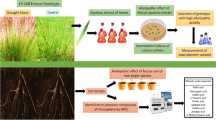Summary
The allelopathic effect of alfalfa (Medicago media Pers.) and red clover (Trifolium pratense L.) root saponins on winter wheat seedling growth and the fate of these chemicals in soil environments were studied. Seed germination, seedling and test fungus growth were suppressed by water and by alcohol extracts of alfalfa roots, and by crude saponins of alfalfa roots, indicating that medicagenic acid glycosides are the inhibitor. Powdered alfalfa roots inhibited wheat seedling growth when added to sand. At concentrations as low as 0.25% (w/w) the root system was completely destroyed whereas seedling shoots suffered little damage. Red clover roots caused some wheat growth inhibition when incorporated to sand, but their effect was much lower than in the alfalfa root treatment.
Soil textures had a significant influence on the inhibitory effect of alfalfa roots. The inhibition of seedling growth was more pronounced on light than on heavy soils. This was attribted to the higher sorption of inhibitors by heavy soils.
Incubation of alfalfa roots mixed into loose sand, coarse sand, loamy sand and clay loam for a period of 0–8 days resulted in decreased toxicity to bothT. viride and wheat seedlings. This decrease occurred more quickly in heavier soils than in loose sand, due to the hydrolysis of glycosides by soil microorganisms. Soil microbes were capable of detoxifying medicagenic acid glycosides by partial hydrolysis of sugar chain to aglycone.
These findings illustrate the importance of medicagenic acid glycosides as an inhibitor of wheat seedling growth, and of their fate in different soil environments.
Similar content being viewed by others
References
Arneson P A and Durbin R D 1967 Hydrolysis of tomatine bySeptoria lycopersici: A detoxification mechanism. Phytopathology 57, 1358–1360.
Bhowmik P C and Doll J D 1982 Corn and soybean response to allelopathic effects of weed and crop residues. Agron. J. 74, 601–606.
Elliot L F, McCalla T M and Waiss F 1978 Phytotoxicity associated with residue management. Am. Soc. Agron. Spec. Publ. 31, 131–146.
Ford J E, McCance D J and Drysdale R B 1977 The detoxification of α-tomatine byFusarium oxysporum F. sp. lycopersici. Phytochemistry 16, 545–546.
Gestetner B, Shany S, Tencer Y, Birk Y and Bondi A 1970 Lucerne saponis. II. Purification and fractionation of saponins from lucerne tops and roots and characterization of the isolated fractions. J. Sci. Food Agric. 21, 502–507.
Guenzi W D, Kehr W R and McCalla 1964 Water soluble phytotoxic substances in alfalfa forage: Variation with variety, cutting year and stage of growth. Agron. J., 56, 499–500.
Jurzysta M 1970 Effect of saponins from seeds of lucerne on germination and growth of cereal seedlings. Zesz. Nauk. UMK Torun 13, 253–256.
Jurzysta M 1979 A simple method of quantification of biologic active alfalfa saponins byTrichoderma viride growth. Bull. Branż. Hod. Roślin 1, 16–18(In Polish).
Kehr W R, Watkins J E and Ogden R L 1983 Alfalfa establishment and production with continuous alfalfa and following soybeans. Agron. J. 75, 435–438.
Kimber R W L 1973 Phytotoxicity from plant residues. II. The effect of time of rotting of straw from some grasses and legumes on the growth of wheat seedlings. Plant and Soil 38, 347–361.
Kobus J 1970 The role of montmorillonite in transformation of organic compounds. Pam. Pul. 39, 189–298 (In Polish).
Lawrance T and Kichler M R 1962 The effect of fourteen root extracts upon germination and seedling length of fifteen plant species. Can. J. Plant Sc. 42, 308–313.
Leshem Y and Levin J 1978, The effect of growing alfalfa on subsequent cotton plant development and on nitrate formation in peat soil. Plant and Soil 50, 323–328.
Marchaim U, Birk Y, Dovrat A and Berman T 1975 Kinetics of the inhibition of cotton seeds germination by lucerne saponins. Plant Cell Physiol. 16, 857–864.
Mishustin B N and Naumova A N 1955 Secretion of toxic substances by alfalfa and their influences upon cotton and soil microflora. Akad. Nauk USSR Izvestija, Ser. Biol. 6, 3–9(In Russian).
Nord E C and VanAtta G R 1960 Saponin a seed germination inhibitor. Forest Sci. 6, 350–353.
Oleszek W and Jurzysta M 1984 Model experiments on the influence of alfalfa and red clover on winter wheat grown in rotation. Proc. Comecon Conf. on Soil Fert. Pulawy, p. 61–67 (In Polish).
Oleszek W and Jurzysta M 1986 Isolation, chemical characterization and biological activity of alfalfa (Medicago media Pers.) root saponins. Acta Soc. Bot. Pol. 55 (In press).
Oleszek W and Jurzysta M 1986 Isolation, chemical characterization and biological activity of red clover (Trifolium pratense L.) root saponins. Acta Soc. Bot. Pol. 55 (In press).
Pedersen M W 1965 Effect of alfalfa saponin on cotton seed germination. Agron. J. 57, 516–517.
Pedersen M W 1975 Relative quantity and biological activity of saponins in germinated seeds, roots and foliage of alfalfa, Crop Sci. 15, 541–543.
Pittman U J and Horricks J S 1972 Influence of crop residue and fertilizers on stand, yield and root rot of barley in southern Alberta. Can. J. Plant Sci. 52, 463–469.
Ream H W, Smith D and Walgenbach R P 1977 Effect of deproteinized alfalfa juice applied to alfalfa-bromograss, bromegrass and corn. Agron. J. 69, 685–689.
Rice E L 1979 Allelopathy an update. Bot. Rev. 45, 15–109.
Shany S, Birk Y, Gestetner B and Bondi A 1970 Preparation, chemical characterization and some properties of saponins from lucerne tops and roots. J. Sci. Food Agric. 21, 131–135.
Author information
Authors and Affiliations
Rights and permissions
About this article
Cite this article
Oleszek, W., Jurzysta, M. The allelopathic potential of alfalfa root medicagenic acid glycosides and their fate in soil environments. Plant Soil 98, 67–80 (1987). https://doi.org/10.1007/BF02381728
Received:
Revised:
Issue Date:
DOI: https://doi.org/10.1007/BF02381728




